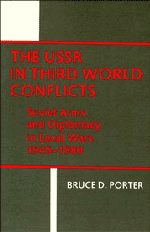Book contents
- Frontmatter
- Contents
- Preface
- 1 Introduction
- 2 The USSR in local conflicts: a historical overview
- 3 Soviet power projection: advances in postwar military capabilities
- 4 The case studies: a framework for analysis
- 5 The Yemeni civil war
- 6 The Nigerian civil war
- 7 The Yom Kippur war
- 8 The Angolan civil war
- 9 The Ogaden war
- 10 Conclusions
- Index
6 - The Nigerian civil war
Published online by Cambridge University Press: 05 August 2011
- Frontmatter
- Contents
- Preface
- 1 Introduction
- 2 The USSR in local conflicts: a historical overview
- 3 Soviet power projection: advances in postwar military capabilities
- 4 The case studies: a framework for analysis
- 5 The Yemeni civil war
- 6 The Nigerian civil war
- 7 The Yom Kippur war
- 8 The Angolan civil war
- 9 The Ogaden war
- 10 Conclusions
- Index
Summary
Another power which is supporting the Federal Government in a very substantial way is, of course, the Soviet Union.. .her motivations are similar to those which propelled the colonial aspirations of Bismarck's Germany in the last century - to have a place in the sun.
Raph Uwechue, Reflections on the Nigerian Civil WarThe Soviet Union's involvement in the Nigerian civil war began in the late summer of 1967. In many ways it was not a propitious time for the USSR to get involved in another local war. The preceding June, Soviet arms had suffered a devastating defeat in the six-day war, and a massive commitment of military aid to the Arabs was required in order to salvage the Soviet Union's prestige and position in the Middle East. Nasser's impending withdrawal from Yemen meant that Moscow would also be forced to increase its military commitment there if the YAR was to be saved. Nigeria's military regime did not appear to offer particularly great promise as a Soviet client, and meeting its weapons requirements would mean the diverting of resources from the priority struggle for influence in the Arab world. The Kremlin went ahead, nonetheless, deterred neither by the prospect of overcommitment nor by sobering memories of its Congo fiasco and other Soviet setbacks in Africa — in Guinea, Ghana, and Mali. Perhaps the Kremlin leaders felt that demonstrations of Soviet largess and capabilities were badly needed and that the Nigerian civil war offered safe and certain victory, given Britain's pro-Federal position, U.S. neutrality, and the Federal army's quantitative superiority over the Biafran forces.
- Type
- Chapter
- Information
- The USSR in Third World ConflictsSoviet Arms and Diplomacy in Local Wars 1945–1980, pp. 90 - 112Publisher: Cambridge University PressPrint publication year: 1984



